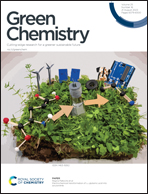Photocatalytic defluorocarboxylation using formate salts as both a reductant and a carbon dioxide source†
Abstract
Herein, we report a photocatalytic defluorocarboxylation of benzylic C(sp3)–F bonds using formate salts as both a reductant and a carbon dioxide source. A variety of benzyl fluorides, bearing primary or secondary C(sp3)–F bonds, undergo defluorinative carboxylation smoothly with HCOOK. This transition metal-free strategy provides a mild, efficient, and sustainable approach for accessing a series of valuable aryl acetic acids, such as flurbiprofen. This protocol also features low catalyst loading, mild reaction conditions, good functional group tolerance, and ready scalability and sustainability. Mechanistic investigations indicate that a carbon dioxide radical anion (CO2˙−) is generated via hydrogen atom transfer (HAT) and acts as a strong reductant to promote single electron reduction of benzyl fluorides. The following nucleophilic attack of carbanions on CO2, both of which are in situ generated intermediates, delivers the desired products, demonstrating the high efficiency of the CO2 capture process.

- This article is part of the themed collections: 130th Anniversary of Wuhan University and 2023 Green Chemistry Hot Articles


 Please wait while we load your content...
Please wait while we load your content...